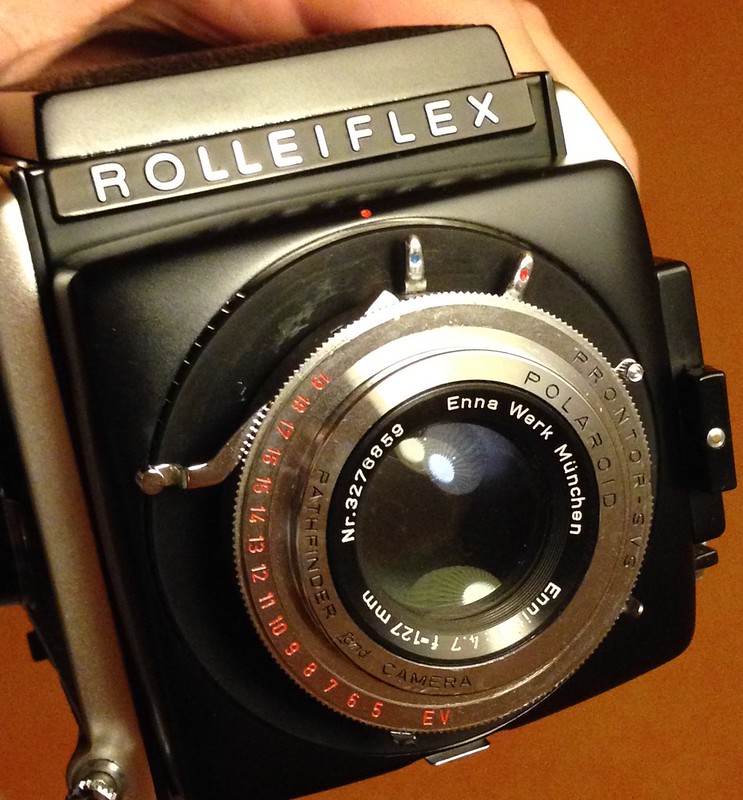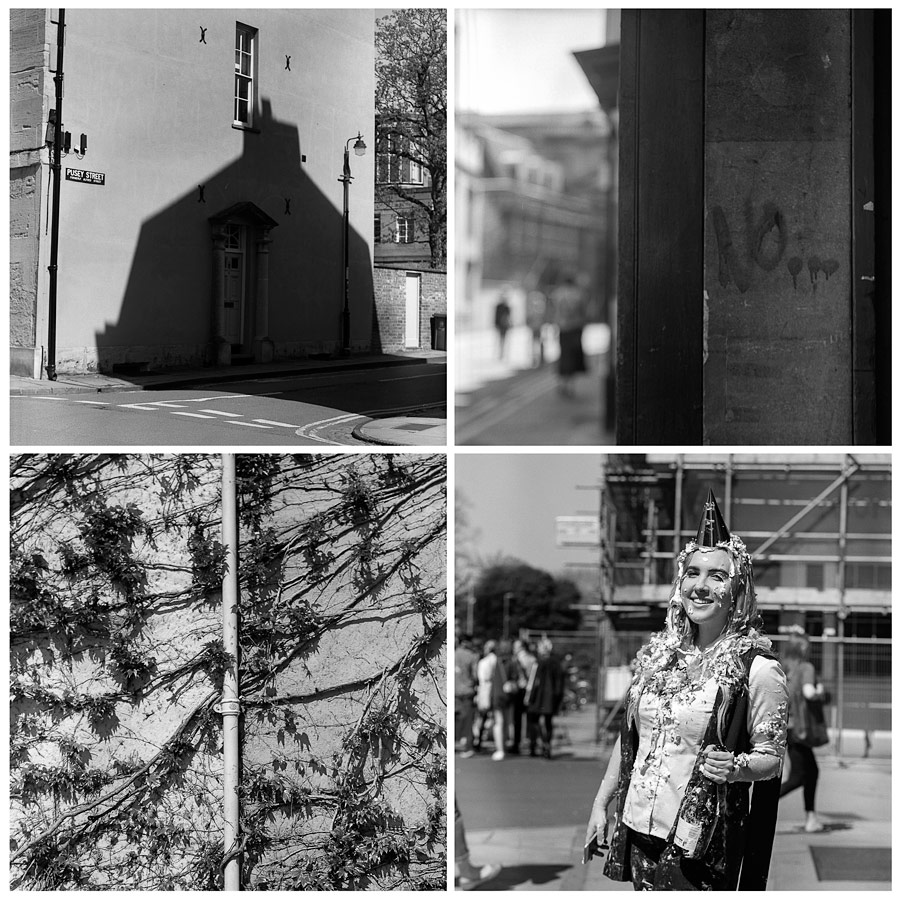Equipment
...now browsing by category
Saturday, February 1st, 2025
Posted in Equipment, film, Oxford, People, Portrait, Street portraits | No Responses »
Tags: 5x4, b&w, film, fomapan 400, graflex, hektor, oxford, portrait, super d, xt-3
Monday, November 18th, 2024
Posted in Equipment, film, Oxford, People, Portrait | No Responses »
Tags: 5x4, black&white, film, fomapan 400, oxford, people, portraits, rodinal
Friday, September 20th, 2024
Posted in Equipment, film, Oxford, People, Portrait, Street portraits | No Responses »
Tags: 5x4, black&white, dallmeyer 2B, film, fomapan 400, graflex, oxford, people, portraits, rodinal, speed graphic
Monday, September 16th, 2024
After replacing the ground glass screen in my Ensign reflex camera I wanted to test it out so I lugged it into town last Sunday morning and here are some shots from that roll. The image is clearer and brighter than before but I’m still struggling to nail focus. The mirror is anything but crisp and looks to be covered in a layer of hazy fog. I’ll have to send it off for re-coating. I can’t reach infinity focus which makes this setup more suited for portraits.
[Tech info:] Ensign Special Reflex, Aero Ektar lens, Delta 100 (expired), developed in Promicrol, 1+19.




Posted in Equipment, film, Oxford | No Responses »
Tags: aero ektar, delta 100, ensign, oxford, promicrol
Friday, March 1st, 2024
Here is my first portrait on dry glass plate. I found a box of old Ilford FP4 glass dry plates at home and have no idea when I bought them. The box doesn’t have an expiry date on it. As luck would have it they’re the correct size (2.5 x 3.5 inches) to fit the Mamiya Press plate holders I’ve got but so far have been unable to make use of. This portrait of another fellow photographer during his visit to Oxford was made last weekend in Radcliffe Square. I don’t know him but I enjoyed chatting about photography with him as I set up the shot. I’m very pleased with this result (it has a vintage feel to it) and look forward to making more portraits with the remaining glass plates. The emulsion is very fragile when wet and you can see it lifted along the right hand side.
[Tech info:] Mamiya Press Super 23, 100/2.8 lens (at f4), FP4 glass dry plate exposed at ISO 10, developed in Rodinal 1+25. (Thanks to Nicholas Middleton for his inspiration and blog posts full of info about using old glass plates).

Posted in Equipment, Oxford, Portrait | No Responses »
Tags: 1+25, 2024, fp4, glass plates, mamiya universal, oxford, portrait, rodinal
Wednesday, December 27th, 2023
Some shots from yesterday when I was testing a Schneider Xenotar lens I recently picked up. Very overcast flat light but the results are OK.
[Tech info:] Chamonix 45F2, 135/3.5 Xenotar lens (yellow filter apart from the portrait), Fomapan 100 @ ISO 64, developed in ID-11 1+1 for 10m 30s.




Posted in Equipment, film, Oxford | No Responses »
Tags: 5x4, black&white, Chamonix, film, fomapan 100, ID11, oxford, xenotar
Tuesday, October 10th, 2023
Posted in Equipment, film, Oxford, People, Portrait | No Responses »
Tags: 65mm, 6x6, black&white, c330, film, fp4, ilford, oxford, people, portraits, students, xt-3
Monday, September 18th, 2023
Posted in Equipment, film, Oxford, People, Portrait | No Responses »
Tags: 125mm, 6x6, adox, black&white, film, fp4, HP5, ilford, leitz, oxford, rolleiflex, SL66, xt-3
Thursday, January 14th, 2021
During December 2020 the UK saw a lot of rainfall and some parts of the country were flooded. I don’t remember Oxford receiving enough rain to cause flooding but as the massive volume of water from other parts comes rushing through Oxford the rivers swell which in turn causes some areas to flood, especially a local meadow. I made the most of the flooding and did some photography with a large format camera I’ve been wanting to try out for a while. It’s custom made with a 75mm Schneider lens which is fitted to a helicoid for focussing and the back rotates – something I found out by accident which was a nice bonus. There is no branding on it but it’s extremely well designed and made.
I wanted to fill the frame with sky and the reflection in the water so I had to stand in the water because a 75mm on 5×4 film gives an extremely wide angle of view. The Benbo Mk 2 tripod is perfect for this because the legs extend upwards from inside the bottom part of the legs and is designed to stand in water. What a didn’t realise was how easily one of the feet would end up coming off in the mud because it had a split in it, something I only noticed once I got back home. Fortunately Paterson in the UK still sell spares and supply them in a pack of 3. I’ve included some behind the scenes pictures below.
[Tech info:] Custom red dot 5×4 camera, 75mm Schneider lens, FP4 film (expired), developed in Kodak HC110 1+31 (-1 minute to prevent the highlights blowing out).








Posted in Equipment, film, Oxford | 2 Responses »
Tags: 5x4, 75mm, black&white, film, flood, fp4, hc110, ilford, meadow, oxford
Thursday, November 12th, 2020
I’ve borrowed a Contax T2 point and shoot camera from a kind friend of mine and have been taking it with me on a few walks recently to see if it lives up to its reputation. So far I can’t say it has. Below are some examples from a recent walk and you can see in three of them only the centre of the frame is in focus and the outer edge of the frame looks so distorted I wonder if there’s an alignment problem with the lens. Surely it can’t be down to a shallow depth of field. The strange thing is in the shot of the moss covered branch (second image) the blurry edges aren’t there so maybe it’s more to do with focussing at infinity? Maybe this is normal for this camera but no one has mentioned it in any reviews? Not sure.
[Tech info:] Contax T2, Eastman Double X film, developed in FPP D96 for 7mins 30secs. Pakon scans.




Posted in Equipment, film | No Responses »
Tags: 2020, 35mm, bagley wood, black&white, d96, double x, film, kodak, pakon
Saturday, December 21st, 2019
Posted in Equipment, film, Oxford, People, Portrait | No Responses »
Tags: 40mm, 6x6, black&white, bronco, film, ilford, oxford, pan f, portraits, sqa, worcester, xtol
Friday, April 20th, 2018
For the past few years I’ve have had a lens sitting around that I wanted to make use of but never quite got around to it, until now. The lens originally came off of the Polaroid 110B Land Camera that I had modified to a 5×4 large format camera and I didn’t see much point in mounting it to a lens board to use on a different 5×4 camera so it’s been sitting around doing nothing. I wanted to adapt it to work on my Rolleiflex SL66 but the only place I knew of that made an adapter was asking around $80 which is more than I wanted to pay but fortunately a friend mentioned RAF Camera where an adapter cost just under half the price.
After modifying the adapter slightly (two small holes need to be drilled so that small screws on the back of the lens can stop it from twisting) it was ready for testing. Below are some test shots from the first roll. A few things to mention are firstly the focal length is a surprise if you’re mostly used to using the 80mm standard lens as I am and I frequently found myself taking a few steps back from where I thought I would need to stand to a given composition. Secondly, the depth of focus is extremely shallow even at f8 and because the image through the viewfinder gets darker as you stop down it’s difficult to get precise focus without a bright focussing screen in your camera – something that affected my hit rate of sharp shots on this roll. I’ll use a tripod for the next roll I use with this setup to see the difference. All shots made during my lunch break.
[Tech info:] Rolleiflex SL66, Enna Werk München 127mm f4.7 lens, Ilford Delta 100 (expired), developed in Tetenal Ultrafin T-Plus.



Posted in Equipment, film, Oxford | No Responses »
Tags: 6x6, black&white, delta 100, film, ilford, land camera, oxford, rolleiflex, SL66, tetenal





































































